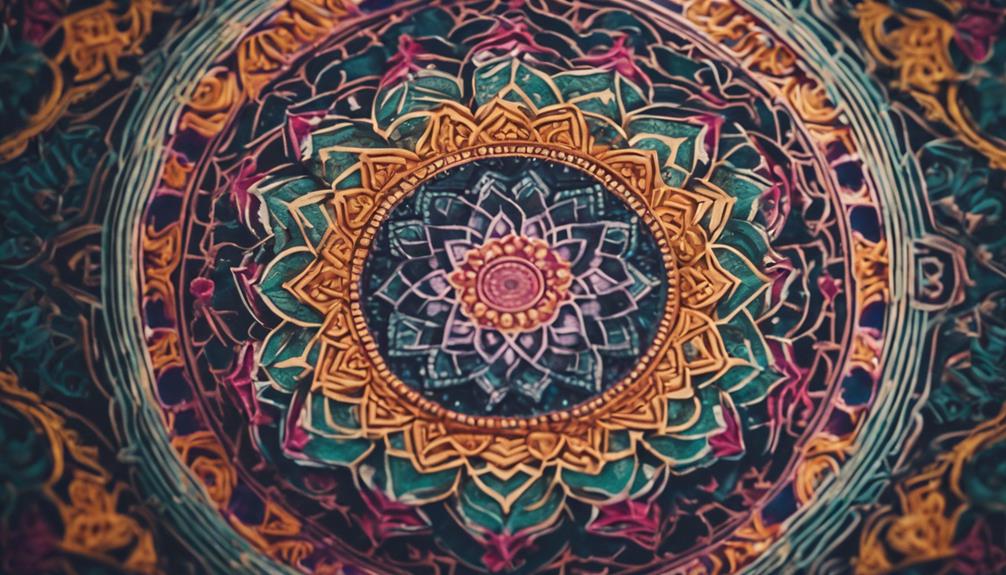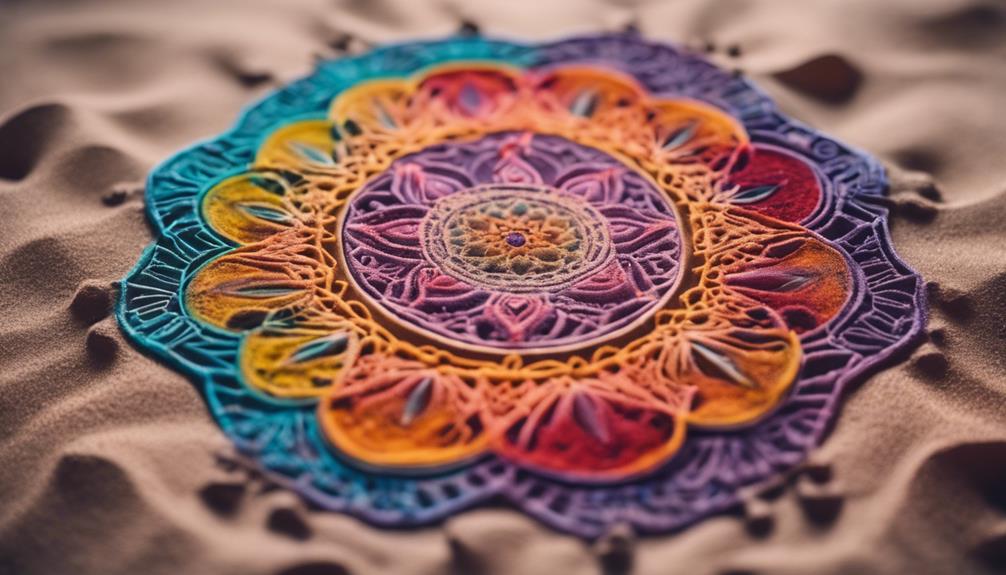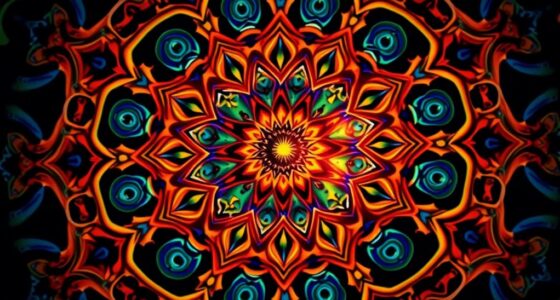Diving into mandalas reveals a vibrant world of designs and meanings across various beliefs. Tibetan mandalas, with their complex shapes, help people meditate to reach higher levels of thought. Hindu mandalas, such as Rangoli, invite gods with colorful powders and unique designs. Geometric mandalas show the order and interconnectedness of the universe, providing more than just eye-catching patterns. Nature-inspired mandalas reflect the beauty of the natural world, bringing calm. Healing mandalas give insights and spiritual growth through meditation. Sand mandalas, a Tibetan tradition, use colorful sand art to represent impermanence. **Mandala meanings cross cultures**, opening doors to spiritual enlightenment. Dive into the rich world of mandalas to uncover more.
Key Takeaways
- Tibetan Mandalas: Intricate designs aiding meditation and visualization in Tibetan Buddhism.
- Hindu Mandalas (Rangoli): Welcome deities with vibrant patterns and cultural significance.
- Geometric Mandalas: Symbolize order and interconnectedness in the universe.
- Nature-Inspired Mandalas: Capture natural beauty to promote tranquility and harmony.
- Healing Mandalas: Facilitate healing energies for peace, clarity, and spiritual growth.
Tibetan Mandalas
Tibetan Mandalas, intricate geometric designs, are essential tools for meditation and visualization practices in Tibetan Buddhism. These sacred spaces of Buddhist art hold deep significance in mandala painting, featuring elaborate geometric patterns that aid in spiritual contemplation. Created by skilled Tibetan Buddhist monks using colored sand, these Mandalas serve as visual aids for practitioners to focus their minds and connect with higher states of consciousness. Through meditation on these intricate designs, individuals seek to attain a sense of inner peace and enlightenment.
The process of constructing Tibetan Mandalas is a meticulous and time-consuming practice that requires patience and precision. The destruction of these Mandalas, often done ceremoniously upon completion, symbolizes impermanence and the transient nature of existence. This act emphasizes detachment and non-attachment to the material world, serving as a powerful reminder of the impermanent nature of life.
Hindu Mandalas

Hindu Mandalas, known as Rangoli, hold deep symbolism and spiritual significance. These colorful designs aren't just decorative; they represent welcoming deities and guests into the home and are believed to bring prosperity and good fortune.
Created with vibrant powders and natural materials, Hindu Mandalas feature intricate patterns of geometric shapes, floral motifs, and religious symbols that carry specific meanings and cultural significance in the rich tapestry of Hindu traditions.
Symbolism in Hindu Mandalas
Symbolism within these intricate Mandalas reflects auspiciousness, prosperity, and the welcoming of deities into Hindu homes during festivals and special occasions.
Hindu Mandalas, such as Rangoli, are vibrant designs crafted on the ground, often using flower petals, colored powders, rice, or sand. These Mandalas serve as a cultural tradition, inviting positive energy and representing good luck and harmony.
They aren't just beautiful patterns but also hold deep spiritual significance in Hindu beliefs. Creating these Mandalas is a way to express artistry and to connect with the divine, making them an integral part of Hindu rituals and practices.
The intricate details and colors used in these Mandalas symbolize the presence of gods and goddesses, infusing spaces with blessings and joy.
Spiritual Significance in Hindu Mandalas
Indulging in the creation of intricate designs with vibrant colors and intricate details, these sacred Mandalas in Hindu culture hold profound spiritual significance. Known as Rangoli, these Hindu Mandalas are revered for symbolizing auspiciousness, prosperity, and the welcoming of deities into homes during festivals and special occasions.
Typically crafted using rice flour, colored powders, flowers, and natural materials, these Mandalas serve as a form of sacred art, reflecting the beauty, spirituality, and cultural richness of Hindu traditions. Passed down through generations, the designs of Hindu Mandalas showcase the continuity of cultural practices and beliefs, emphasizing the deep-rooted spiritual significance embedded within these exquisite creations.
Geometric Mandalas

Geometric Mandalas intricately weave together precise geometric patterns such as circles, squares, triangles, and lines to symbolize order and interconnectedness in the universe. These mandalas, although different from the intricate designs of Hindu mandalas, hold their own significance in Buddhist practices. Through their mathematical form, they offer a visual art that extends beyond mere aesthetics.
The layers of meaning within geometric mandalas speak to the symbolic representation of the universe's structured complexity. The repetitive geometric shapes that often radiate from the center of these mandalas reflect the infinite possibilities and interconnected nature of existence. By emphasizing precision, balance, and mathematical elements, geometric mandalas provide a unique lens through which to contemplate the order and symmetry present in the cosmos.
For those seeking a deeper understanding of the universe's intricacies, exploring geometric mandalas can offer profound insights into the interconnected fabric of reality.
Nature-Inspired Mandalas

How do Nature-Inspired Mandalas capture the essence of natural beauty and interconnectedness through intricate designs?
Nature-inspired Mandalas draw inspiration from elements such as flowers, animals, and landscapes to celebrate the beauty and harmony found in nature, reflecting the interconnectedness of all living beings. These Mandalas not only serve as a way to find peace and inner balance through the use of natural motifs and patterns but also foster a deeper connection with the natural environment, promoting a sense of tranquility.
Personalized Mandalas inspired by nature provide a unique avenue for self-expression and reflection on the beauty of the natural world. By incorporating elements from nature into these intricate designs, individuals can express their admiration for the environment while finding solace in the intricate patterns that mirror the interconnectedness of all living things.
Nature-inspired Mandalas offer a serene escape into the tranquility of natural beauty, allowing for both artistic expression and a deeper connection with the world around us.
Healing Mandalas

Healing Mandalas, with their intricate designs and symbolism, offer individuals unique insights and healing energies for meditation and wisdom. These mandalas are crafted to facilitate meditative practices, fostering inner peace and mental clarity. By focusing on the symbolic representations within the mandala, individuals can experience emotional healing and spiritual growth. For example, Kalachakra Mandalas, known as the 'Cycle of Time' mandalas, have the power to transform ordinary minds into enlightened ones.
Through the act of engaging with Healing Mandalas, individuals can access profound healing energies that promote holistic well-being. The patterns and colors within these mandalas are deliberately chosen to evoke specific emotions and aid in the healing process. By immersing oneself in the beauty and complexity of a healing mandala, one can commence on a journey towards inner harmony and self-discovery. These sacred symbols serve as powerful tools for anyone seeking to cultivate a sense of peace and balance in their lives.
Sand Mandalas

Sand mandalas are a traditional practice in Tibetan Buddhism. Monks create intricate designs using colored sand grains and precise hand movements. These designs symbolize impermanence, as they are intentionally destroyed after completion, highlighting the transient nature of life.
Monks perform a consecration ceremony before beginning the creation of a sand mandala. This ceremony infuses the artwork with spiritual significance.
Intricate Sand Designs
Delicately crafted with vibrant hues, intricate sand designs, known as Sand Mandalas, serve as profound symbols of impermanence and blessings within Tibetan Buddhist traditions. Tibetan Buddhist monks meticulously create these intricate designs using fine multi-colored sand grains as a form of meditative art.
The process involves pouring millions of sand grains over days to complete the mandala. After completion, the sand mandalas are traditionally destroyed to symbolize impermanence and share their blessings. Dispersing the sand from a finished mandala is a ritual that spreads the blessings and reminds observers of the impermanent nature of existence.
Symbolism in Sand Art
Tibetan Buddhist monks intricately craft sand mandalas using colored sand grains to symbolize impermanence and blessings within their tradition. These intricate designs represent the cycle of life, emphasizing the impermanent nature of existence.
The meticulous process of pouring sand to form geometric patterns reflects the monks' reverence for the interconnectedness of all things. Through consecration ceremonies, the sand mandalas are imbued with positive energy, serving as a visual prayer for the well-being of all beings.
Dismantling the completed mandala is a significant ritual that underscores the impermanence of life, teaching the lesson of letting go. The blessed sand is then dispersed to share its positive energy with the world, spreading the monks' intentions of peace and harmony.
Mandala Symbolism

Mandalas symbolize the interconnectedness of the universe through their intricate geometric patterns, reflecting unity and harmony. These sacred symbols hold deep spiritual significance across different cultures, serving as tools for meditation and contemplation.
In Buddhism, the teaching mandala represents the universe, aiding practitioners in understanding the interconnectedness of all beings. The purpose of meditation with mandalas is to access higher states of consciousness by focusing on the center and allowing the mind to enter a state of deep awareness.
Mandalas are symbolic representations of the microcosm within the cosmos, reminding individuals of their place in the vast web of existence. Through their profound symbolism, mandalas act as portals to higher planes of understanding and spiritual enlightenment.
Frequently Asked Questions
What Are the 5 Common Symbols in Mandalas?
Common symbols in mandalas include:
- The lotus flower for purity
- The wheel with eight spokes for the Eightfold Path
- The bell shape for wisdom
- The square for stability
- The center dot for unity
Each symbol carries its own significance, contributing to the overall meaning and representation within a mandala. These symbols are essential elements that enrich the visual and spiritual aspects of mandalas.
What Does the 8 Point Mandala Mean?
The 8 point mandala in Buddhism symbolizes the Eightfold Path, guiding individuals towards enlightenment. Each point represents a different aspect of the spiritual journey, like right view and right mindfulness.
This sacred design aids in meditation and growth by focusing on Buddhist principles. The intricate symbolism of the 8 point mandala aims to lead practitioners toward wisdom, ethical conduct, and mental discipline on their spiritual path.
What Are 3 Primary Components of Mandalas?
Mandalas consist of three primary components: outer, inner, and secret meanings.
The outer meaning symbolizes the universe's divine form and interconnectedness.
Inner meanings guide towards enlightenment through meditation.
Secret meanings hold personal significance.
Mandalas aim to balance body and mind, offering spiritual insight through design and symbolism.
What Are the Five Uses of Mandalas?
Mandalas serve five main purposes:
- Aiding in meditation to enhance focus and tranquility
- Acting as personal artifacts with unique meanings
- Representing aspects of one's spiritual journey or beliefs
- Serving as symbols, prayers, and sources of meditation in religious settings
- Guiding individuals towards enlightenment in Buddhism
These intricate designs can be painted, drawn, or created from colorful sand, offering diverse ways to engage with their healing and spiritual properties.
What Are the Symbolic Meanings Behind Different Types of Mandalas?
Mandalas have deep spiritual significance, and different types of mandalas carry various symbolic meanings. They can represent balance, unity, and harmony. Just like types of dream catchers symbolic meanings, mandalas can also be seen as a form of protection and a way to connect with the spiritual universe.
Conclusion
To sum up, mandalas come in various forms, each with its own unique meanings and significance. Whether it's the intricate designs of Tibetan Mandalas, the spiritual symbolism of Hindu Mandalas, or the geometric patterns of Geometric Mandalas, these sacred artworks hold deep cultural and spiritual significance.
From nature-inspired mandalas to healing mandalas, and even intricate sand mandalas, the diversity of mandalas showcases the rich tapestry of traditions and beliefs that have shaped these beautiful creations.











